With over 5.07 billion active users and the average person spending more than 2 hours daily on social platforms, social media has become an essential part of business growth.
As we approach 2025, trends like generative AI, social listening, and content experimentation will continue to reshape the digital landscape.
To stay ahead, you need to equip your team with the right tools and strategies.
Social media management platforms help teams streamline content creation, scheduling, and performance analysis, making it easier to manage multiple platforms seamlessly.
This guide covers the social media management for teams, tools, and strategies your team needs to succeed in 2025 and beyond.
Let’s get started!

Tired of juggling multiple tools for your team’s social media management?
With Social Champ, you can simplify your workflow, streamline content scheduling, and enhance collaboration, all in one powerful platform.
Short Summary
- Effective social media management is essential for teams, as social platforms serve as vital connections between brands and their audiences.
- Achieving success in this area requires strategic planning, collaboration, and the ability to adapt to evolving trends and algorithms.
- Collaboration plays a crucial role in ensuring consistency, quality, and efficiency across various platforms.
- Common challenges include maintaining uniformity, managing large volumes of content, and addressing negative feedback.
- Clear communication and well-defined workflows are vital to prevent missed deadlines, redundant efforts, and disorganization.
- Tools like Social Champ can enhance team management by offering features such as role assignments, approval workflows, and real-time communication.
- Teams should implement best practices, such as utilizing a content calendar, encouraging open dialogue, and regularly reviewing analytics to boost performance.
Why Effective Social Media Management Is Critical for Teams
Effective social media management is no longer a luxury for teams—it’s a necessity.
In an era where social platforms serve as the primary touchpoints between brands and their audiences, managing these channels effectively is critical to maintaining a competitive edge.
For teams, social media management involves more than just posting content; it requires strategic planning, seamless collaboration, and real-time adaptability to ever-changing trends and social media algorithms.
Without an organized approach, teams risk missing opportunities to engage their audience, build trust, and drive measurable business outcomes.
Collaboration is a key element of successful social media management.
Whether it’s brainstorming ideas, scheduling posts, or analyzing performance, teams must work cohesively to ensure consistency and quality across platforms.
Disjointed efforts can lead to missed deadlines, duplicate work, and a fragmented brand image.
By implementing clear workflows and utilizing tools designed for team collaboration, organizations can streamline their efforts and improve efficiency.
These capabilities allow brands to be more responsive and proactive, ensuring their content resonates with their target demographic.
Featured Article: What Is a Social Media Coordinator?
Top Challenges Teams Face in Managing Social Media
Managing social media for teams can be rewarding but also comes with its fair share of challenges.
As platforms evolve and audience expectations grow, teams must navigate a variety of obstacles to stay effective and relevant.
Here are the top challenges teams commonly face and how they impact social media management.
-
Maintaining Consistency Across Platforms
With multiple social media platforms in use, ensuring consistent messaging and branding can be difficult.
Each platform has unique formats, audience behaviors, and best practices, making it challenging to tailor content while maintaining a cohesive brand voice.
Without proper coordination, teams risk confusing their audience or diluting their message.
-
Effective Collaboration and Communication
Social media management involves many moving parts—content creation, scheduling, responding to followers, and analyzing data.
For teams, poor communication and unclear roles can lead to missed deadlines, duplicate work, and inefficiencies.
Ensuring everyone is aligned on goals and responsibilities is critical for smooth collaboration.
-
Keeping Up With Algorithm Changes and Trends
Social media algorithms and trends change frequently, often without much warning.
Staying updated with these changes is essential to maintain visibility and engagement.
Teams often struggle to adapt quickly, which can lead to reduced reach and engagement if strategies aren’t updated in time.
-
Managing High Volumes of Content
Creating, curating, and scheduling large volumes of content can be overwhelming for teams, especially when managing multiple platforms.
Balancing quality and quantity while meeting deadlines requires robust planning and streamlined workflows.
Without the right tools, teams can easily become overburdened.
-
Handling Negative Feedback and Crisis Management
Social media is a public platform, and negative feedback or crises can arise at any time.
Responding promptly and professionally is vital to maintaining a positive reputation.
However, many teams find it challenging to address criticism effectively while protecting the brand’s image.
-
Measuring ROI and Proving Value
One of the biggest challenges is demonstrating the impact of social media efforts on business goals.
Tracking and analyzing metrics to prove ROI requires the right tools and expertise.
Teams often face difficulty translating engagement numbers into tangible business outcomes like sales or brand loyalty.
-
Resource Constraints
Social media management can demand significant time, skills, and tools.
Small teams or businesses with limited budgets often struggle to manage the workload, particularly during busy periods like product launches or seasonal campaigns.
-
Ensuring Data Security and Privacy Compliance
With increasing concerns about data security and privacy regulations, teams must ensure their social media practices comply with legal standards.
Mishandling user data or violating policies can lead to penalties and damage a brand’s reputation.
Features to Look for in Social Media Management Tools for Teams
When choosing a social media management tool for teams, it’s essential to focus on key capabilities that ensure smooth collaboration, efficiency, and effective content delivery.
Here are some must-have features to consider:
-
Team Roles and Permissions
A good social media management tool should allow you to assign different roles and permissions to team members, ensuring that each person can access only the features they need.
Whether it’s content creators, managers, or analysts, this feature helps maintain clarity and accountability within the team.
-
Approval Workflows
Approval workflows are crucial for ensuring that content goes through the right checks before being published.
A tool should allow for easy routing of content through a multi-step approval process, reducing the risk of errors or oversight.
-
Analytics and Reporting
Built-in analytics are vital for tracking the performance of your social media campaigns.
A tool that provides detailed reporting on engagement, reach, conversions, and other key metrics will help your team make data-driven decisions to optimize your strategies.
-
Content Calendar
A content calendar is an essential feature for planning, organizing, and scheduling posts across multiple social media platforms.
This feature ensures that content is aligned with your overall marketing strategy and published at the right time.
-
Collaboration Tools
Effective collaboration tools like in-app communication, file sharing, and comment sections help streamline teamwork and improve productivity.
This ensures that team members can easily discuss ideas and provide feedback within the platform.
-
Automated Posting and Scheduling
The ability to schedule posts in advance can save significant time, especially when managing multiple accounts.
Look for a tool that offers automated posting with optimal scheduling to ensure your content reaches your audience at the right time.
Social Champ offers all of these key features, including team roles and permissions, approval workflows, detailed analytics, content calendar, collaboration tools, and scheduling.
Featured Article: Enterprise Social Media Management: Essential Tools for 2025
How Social Champ Simplifies Social Media Management for Teams
Managing social media as a team requires a platform that fosters seamless collaboration, ensures accountability, and simplifies scheduling tasks.
Social Champ offers a robust suite of features tailored to meet these needs, making it a top choice for teams.
-
Effortless Team Collaboration
Social Champ’s intuitive interface allows team members to work together effectively. The platform includes:
- In-App Communication: Team members can discuss campaigns, exchange ideas, and provide feedback without leaving the tool.
- Task Assignments: Assign specific tasks, such as content creation or performance monitoring, to individual team members for better clarity and efficiency.
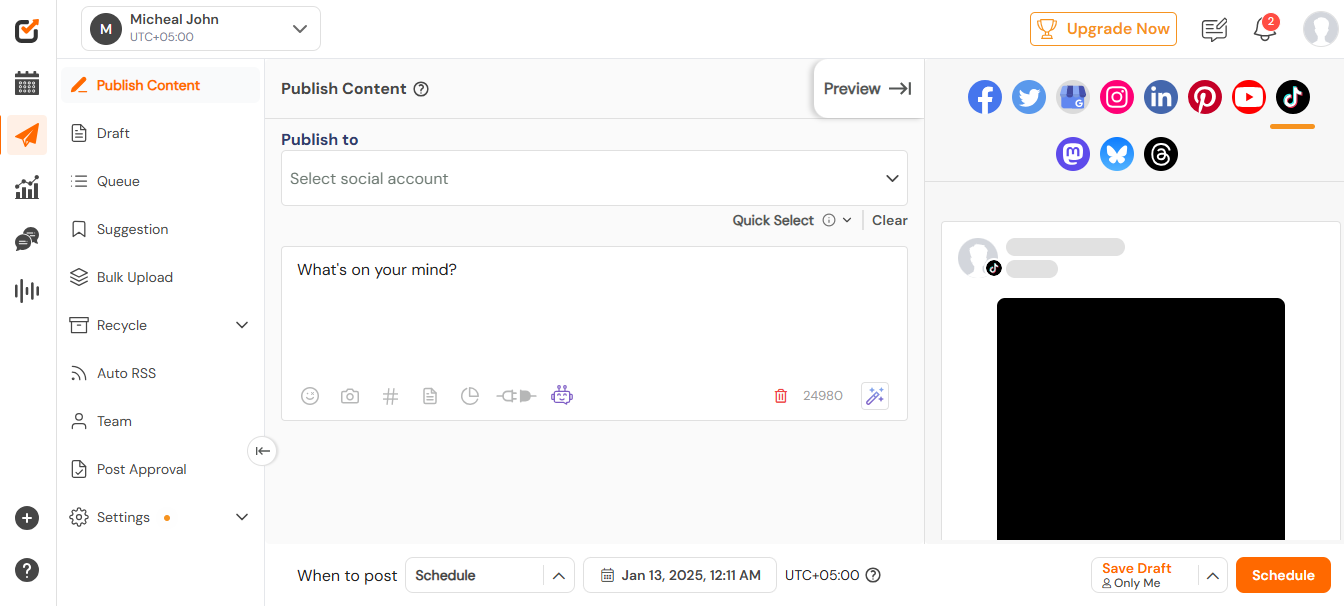
Social Champ’s Dashboard -
Role-Based Access Control
With Social Champ, you can set distinct roles and permissions to maintain control and streamline workflows.
- Customizable Roles: Assign roles such as Admin, Editor, and Viewer based on responsibilities, ensuring access to the appropriate tools and data.
- Secure Collaboration: By limiting access to sensitive data or features, Social Champ protects your brand while empowering your team to excel.
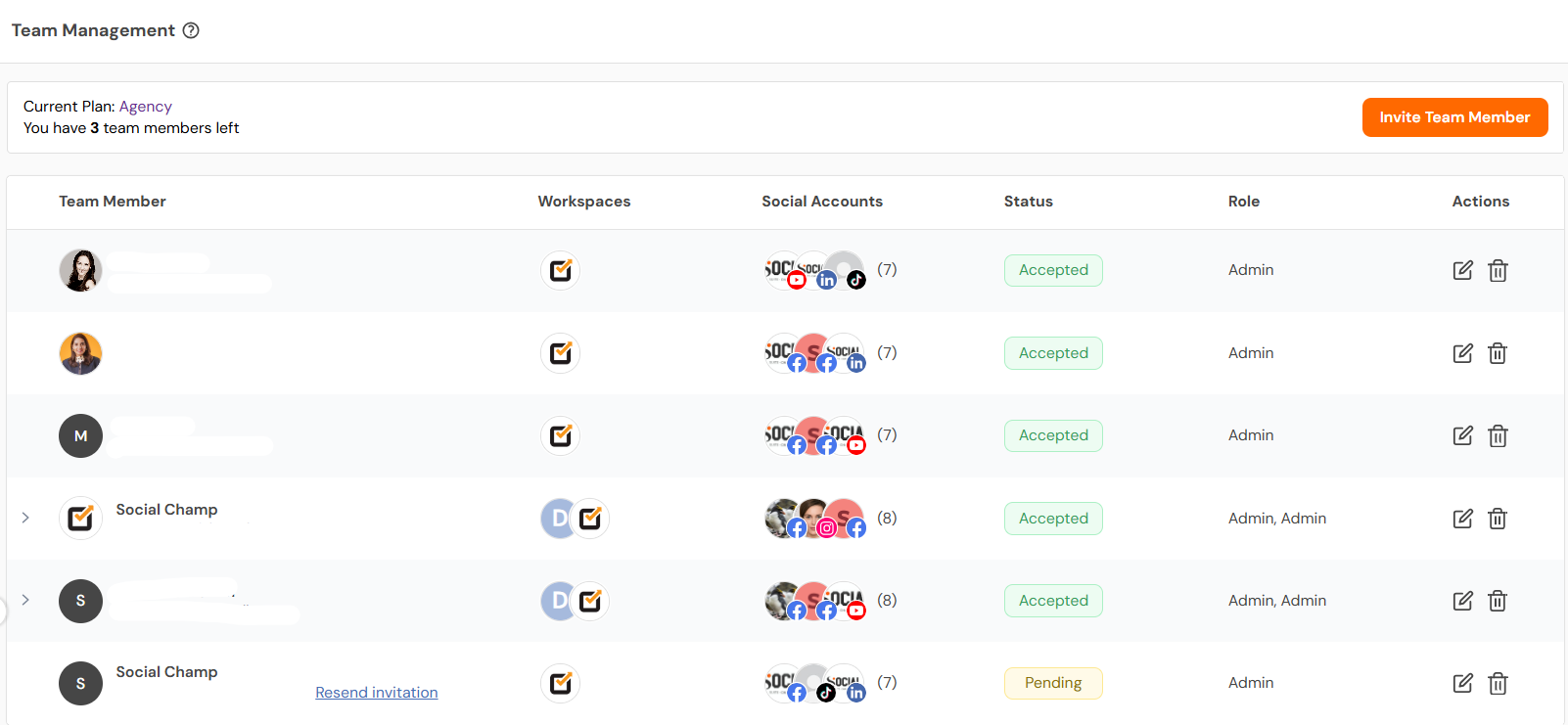
Social Champ’s Team Management -
Smart Scheduling Features
Scheduling social media posts becomes a breeze with Social Champ’s advanced automation capabilities.
- Content Calendar: A visually rich calendar that lets your team plan and organize posts for weeks or even months in advance.
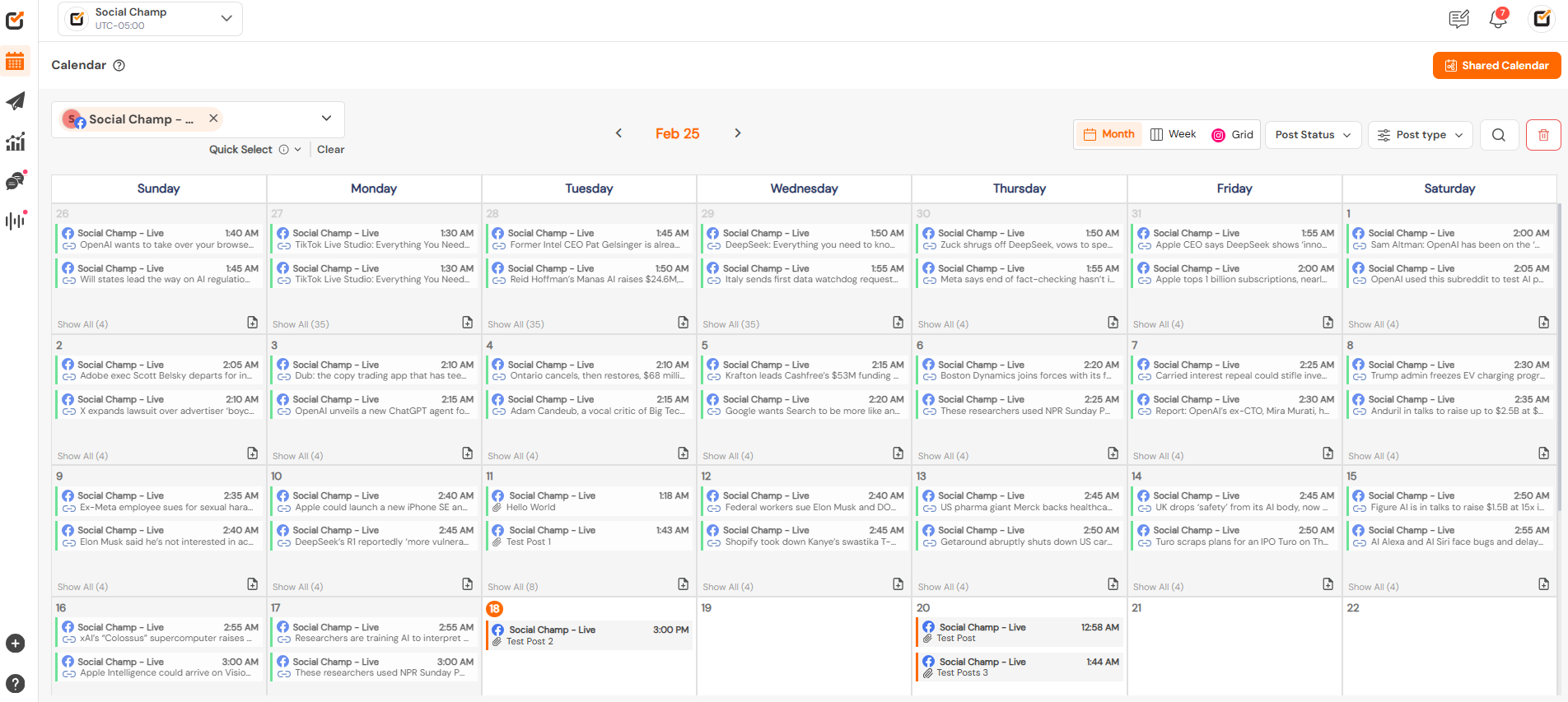
Social Champ’s Content Calendar - Optimal Timing: Use Social Champ’s suggestions to schedule posts at the best times for audience engagement.
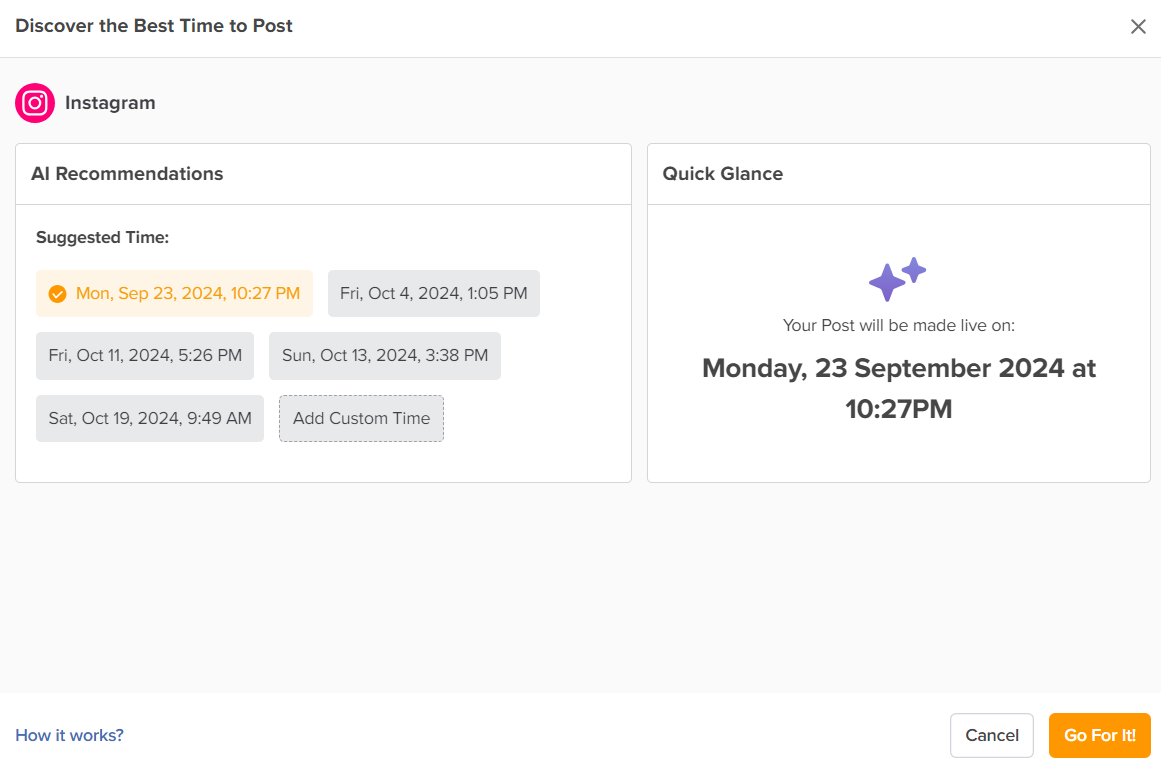
Social Champ’s AI Recommended Best Time to Post on Instagram - Bulk Upload: Simplify your workflow by uploading and scheduling multiple posts at once, saving time and effort.
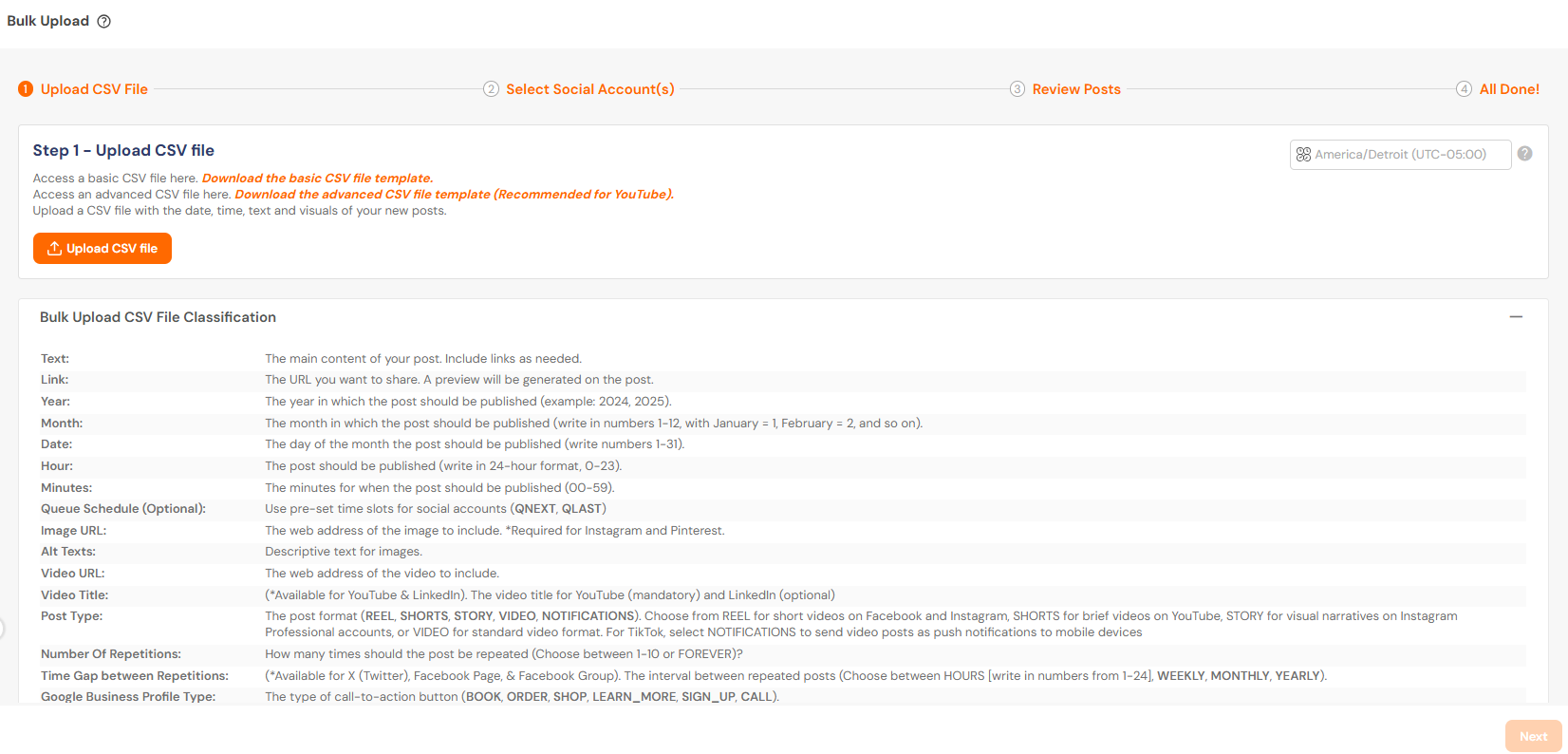
Social Champ’s Bulk Upload
- Content Calendar: A visually rich calendar that lets your team plan and organize posts for weeks or even months in advance.
-
Streamlined Approval Workflows
Social Champ ensures content quality and consistency through its robust approval workflows.
- Multi-Step Approval: Content can be routed through multiple stakeholders for review and approval before it goes live.
- Real-Time Notifications: Keep your team updated on the status of approvals to avoid delays.
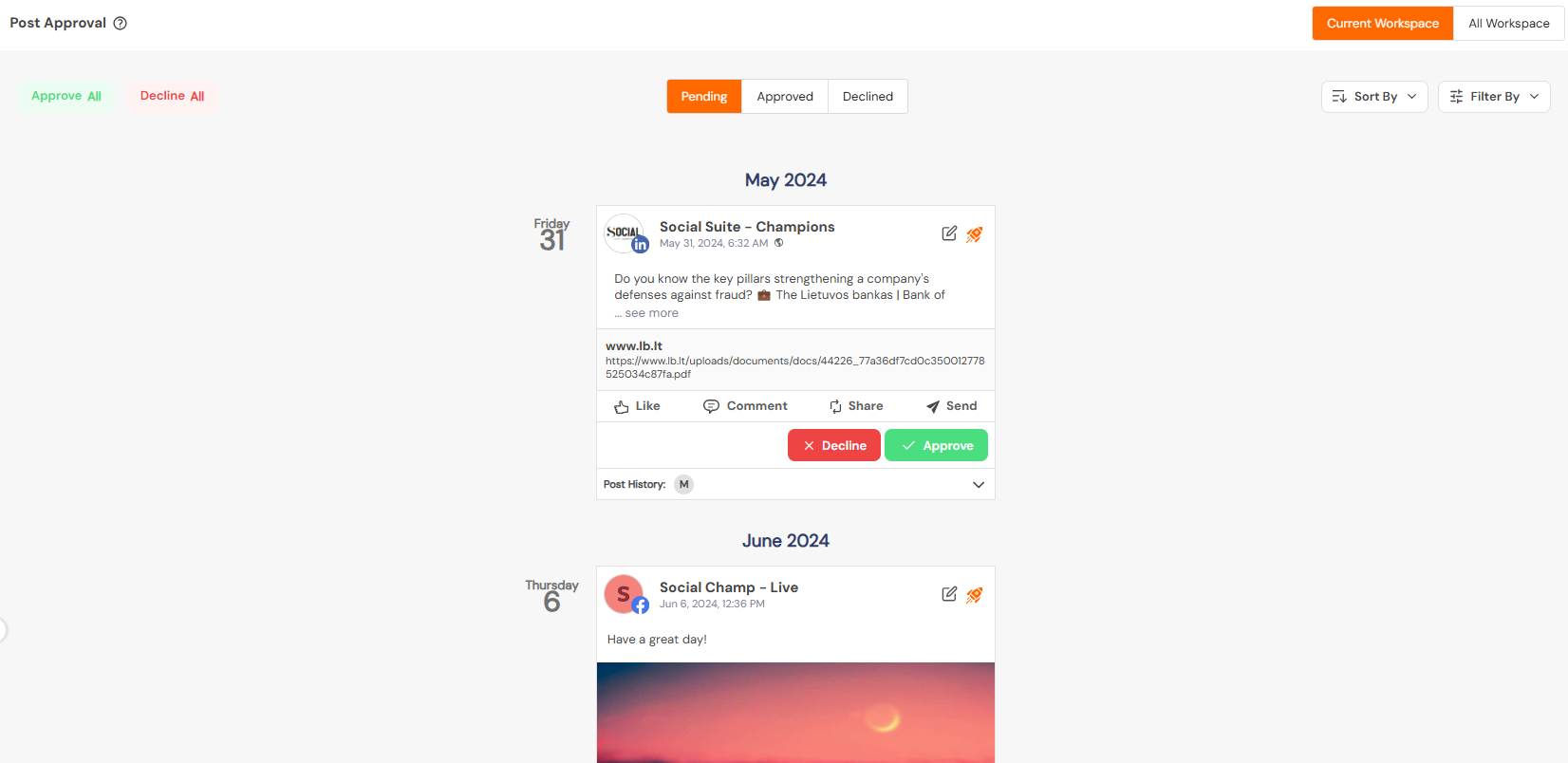
Social Champ’s Post Approvals -
Detailed Analytics and Reporting
Measure the success of your social media efforts with Social Champ’s analytics tools.
- Performance Metrics: Get insights on engagement, impressions, and other KPIs to evaluate your campaigns.
- Custom Reports: Generate detailed reports tailored to your team’s objectives, making it easier to share results with stakeholders.
Why Teams Love Social Champ
Social Champ brings together all the essential features a team needs for effective social media management.
Its focus on collaboration, control, and automation ensures that your team can focus on creating impactful content while leaving the logistics to the tool.
By using Social Champ, teams can improve productivity, maintain consistency, and achieve better results across all social media platforms.
Collaboration Best Practices for Social Media Teams
Effective collaboration is essential for social media teams to achieve their goals, ensure consistency, and manage campaigns efficiently.
Here are some best practices to foster teamwork and maximize productivity:
-
Define Clear Roles and Responsibilities
Assigning specific roles ensures that each team member knows their responsibilities and avoids duplication of efforts. For example:
- Content Creator: Focuses on writing and designing posts.
- Social Media Manager: Oversees strategy, scheduling, and performance.
- Analyst: Monitors metrics and reports on campaign success.
By defining roles, your team can work together seamlessly without confusion.
-
Use a Centralized Tool
A centralized social media management tool, like Social Champ, can streamline workflows. These tools help teams:
- Schedule posts efficiently.
- Collaborate in real-time with features like task assignments and comments.
- Manage multiple platforms from a single dashboard.
Using one tool keeps everyone aligned and reduces the risk of errors.
-
Establish a Content Calendar
A shared content calendar provides a clear overview of upcoming posts, campaigns, and deadlines. Benefits include:
- Improved planning and scheduling.
- Reduced last-minute stress.
- Better alignment with marketing goals and events.
Ensure your team regularly updates and reviews the calendar to stay on track.
-
Set Up an Approval Workflow
To maintain quality and consistency, establish a structured approval process for all social media content.
- First Review: Content is reviewed for brand voice and accuracy.
- Final Approval: Managers or stakeholders approve before publishing.
This minimizes errors and ensures all posts align with your brand identity.

Ready to Make Social Media Management a Breeze?
Try Social Champ and streamline your team’s social media management. Effortlessly schedule posts, collaborate in real-time, and boost your productivity.
-
Foster Open Communication
Encourage regular communication among team members to share updates, address challenges, and celebrate successes.
- Use collaboration tools like Slack, Microsoft Teams, or in-app messaging in your social media platform.
- Schedule regular check-ins to discuss progress and resolve roadblocks.
Clear communication keeps everyone informed and reduces misunderstandings.
-
Leverage Analytics for Improvement
Regularly review social media analytics to evaluate performance and identify areas for improvement.
- Share insights with the team to guide future campaigns.
- Use data to adjust strategies and focus on what works best.
Collaborating on analytics ensures that everyone is aligned with the team’s goals.
-
Create a Style Guide
A style guide ensures consistency in tone, visuals, and messaging across all platforms. Include:
- Brand colors and fonts.
- Voice and tone guidelines.
- Hashtag usage rules.
Share the guide with the team to maintain a unified brand presence.
-
Encourage Creativity and Feedback
Create a culture where team members feel comfortable sharing ideas and giving feedback.
- Host brainstorming sessions for new campaigns.
- Encourage feedback on what’s working and what could be improved.
This leads to more innovative campaigns and continuous improvement.
-
Monitor Workloads
Ensure that tasks are evenly distributed among team members to avoid burnout.
- Use project management tools like Trello or Asana to track workloads.
- Adjust assignments as needed to maintain balance and productivity.
-
Celebrate Successes
Recognize and celebrate team achievements, big or small.
- Highlight successful campaigns in team meetings.
- Reward individual contributions to boost morale.
Acknowledging success motivates the team to continue performing at their best.
By implementing these best practices, social media teams can work more effectively, produce higher-quality content, and achieve their goals with ease.
Conclusion
Effective social media management for teams in 2025 requires a blend of strategy, collaboration, and the right tools.
By using centralized platforms, fostering clear communication, and following best practices for teamwork, teams can streamline workflows and deliver impactful content consistently.
As social media continues to evolve, staying adaptable and data-driven will be key to achieving long-term success.
Empower your team with defined roles, robust analytics, and creative freedom to ensure your social media strategy drives engagement, builds your brand, and meets your business objectives.
With these principles, your team will be well-equipped to thrive in the ever-changing digital world.









